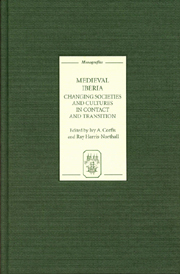Book contents
- Frontmatter
- Contents
- Acknowledgements
- Introduction
- Part 1 SOCIAL AND CULTURAL MINORITIES IN CHANGING SOCIETIES
- Part 2 CONTACT AND CONFLICT: PERSPECTIVES ON HISTORY AND CULTURE
- Part 3 TRANSMISSION OF LEARNING AND TEXTS IN CHANGING CULTURES
- Part 4 LINGUISTIC CONTACT AND CHANGE
- Perils of Speaking of Orígenes de la lengua
- Aspects of Official Language Usage in Castile and León: Latin and the Vernacular in the Early Thirteenth Century
- Considering Paradigmatic Factors in the Reduction of Old Spanish sodes > sois
- Index
Considering Paradigmatic Factors in the Reduction of Old Spanish sodes > sois
from Part 4 - LINGUISTIC CONTACT AND CHANGE
Published online by Cambridge University Press: 12 September 2012
- Frontmatter
- Contents
- Acknowledgements
- Introduction
- Part 1 SOCIAL AND CULTURAL MINORITIES IN CHANGING SOCIETIES
- Part 2 CONTACT AND CONFLICT: PERSPECTIVES ON HISTORY AND CULTURE
- Part 3 TRANSMISSION OF LEARNING AND TEXTS IN CHANGING CULTURES
- Part 4 LINGUISTIC CONTACT AND CHANGE
- Perils of Speaking of Orígenes de la lengua
- Aspects of Official Language Usage in Castile and León: Latin and the Vernacular in the Early Thirteenth Century
- Considering Paradigmatic Factors in the Reduction of Old Spanish sodes > sois
- Index
Summary
The loss of /-d-/ from the segment -odes of OSp. sodes has normally been included with that of the Old Spanish second person verbal suffixes -ades, -edes and -ides. On the one hand, the inclusion of -odes in any analysis of the reduction of -ades, -edes and -ides is not only logical, but also methodologically sound, whether this reduction is viewed as a case of straightforward sound change or as the result of a combination of phonological and morphological factors. The /-d-/ occurs in the same phonetic environment (i.e., intervocalically) and constitutes the first element of the second person plural verbal suffix /-des/ in all four segments. On the other hand, one could argue that the reduction of -odes might be better analyzed apart from that of -ades, -edes and -ides, or that at least it be given further attention after its analysis with the other three, since it differs from these in two very important respects. First, while -ades, -edes and -ides functioned as suffixes of entire verb classes, -odes belonged to only one verb form. Second, and more importantly, while the vowel immediately preceding the suffix /-des/ of -ades, -edes and -ides was a theme vowel, indicating conjugation class and mood, e.g., /amádes/→ /am-/ (root) + /-a-/ (theme vowel) + /-des/ (suffix), the vowel immediately preceding the suffix /-des/ of sodes belonged to the root, i.e., /sódes/→/só-/ (root) + /-des/ (suffix).
- Type
- Chapter
- Information
- Medieval IberiaChanging Societies and Cultures in Contact and Transition, pp. 175 - 184Publisher: Boydell & BrewerPrint publication year: 2007

